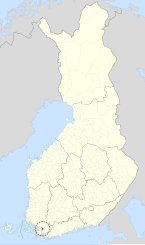Angelniemi (Finnish pronunciation: [ˈɑŋːelˌnie̯mi]) is a former municipality of Finland. It became part of Halikko in 1967. It was located on partly on the continent by the Halikonlahti Bay and partly on Kimito Island and is still nowadays the only part of the island where Finnish is the primary language. Today the population of the area is 398, but it rises during the summer because of the summer cottages.[8]
Angelniemi | |
|---|---|
Former Municipality | |
| Angelniemen kunta Angelniemi kommun | |
 | |
| Country | |
| Region | Southwest Finland |
| Sub-region | Salo |
| Established | 1916 |
| Merged | 1967 |
| Seat | Kokkila |
| Area | |
| • Urban | 63.7 km2 (24.6 sq mi) |
| Population | |
| • Density | 0/km2 (0/sq mi) |
| • Urban density | 16.5/km2 (43/sq mi) |
| • Metro | 1,051 |
| statistics from 1961[4] | |
| Time zone | UTC+02:00 (EET) |
| • Summer (DST) | UTC+03:00 (EEST) |
| Climate | Dfb |


The center of the municipality was Kokkila, which lies on the continent. There is a cable ferry which connects Kokkila to the Kimito Island. Other isles of Angelniemi are Angelansaari, Kokkilansaari, Pikkusaari and Karhusaari.
Angelniemi congregation was established 1657 as a chapel of Halikko. Angelniemi became independent 1916 and it reached its high in 1957 at 1,217 people.[4] In 1967 Angelniemi was merged back to Halikko.
Villages
editAhtmaa, Angela, Asila, Esselpää, Isokylä, Kanamäki, Karviainen, Kokkila, Myllyperä, Paatelmaa, Peksala, Päärnäspää, Pöylä, Sapalahti, Tammenpää, Toppjoki, Torkkila, Tuiskula, Valttila
History
editAngelniemi was originally a farm named Angela within the village of Päärnäspää. The name Angela is derived from the dialectal word angelma meaning "Filipendula sp." (standard Finnish angervo). A village by that name has existed at least since 1540, when it was mentioned as Anghela and a part of the Halikko parish.
Angelniemi became a chapel community in 1659 and was called Korpi. The name Angelniemi for the parish appears in 1692, but it was also called Päärnäspää since the church was located in the village of Päärnäspää. The name Angelniemi became the dominant name because its first chaplain, Petrus Gregorii, started using Angelnius as his surname. The names Korpi and Päärnäspää were still occasionally used for the parish until the late 18th century. The names Korvinen, Andelma and Angela were also occasionally used for the parish.[9]
The Angelniemi church was built in 1772-1774 by Matti Åkerblom. Today, the church and the peninsula it is on are classified as a built-up cultural environment of national significance.[10] Angelniemi became a separate municipality and parish in 1916.
Angelniemi became a part of Halikko again in 1967. Halikko was consolidated with Salo in 2009.
See also
editReferences
edit- ^ a b c d "Area of Finnish Municipalities 1.1.2018" (PDF). National Land Survey of Finland. Retrieved 30 January 2018.
- ^ a b c d "Finland's preliminary population figure was 5,625,011 at the end of August 2024". Population structure. Statistics Finland. 2024-09-24. ISSN 1797-5395. Retrieved 2024-09-25.
- ^ "Key figures on population by region, 1990-2022". StatFin. Statistics Finland. Retrieved 28 October 2023.
- ^ a b Statistics of Angelniemi (in Finnish)
- ^ a b c d e f g h i j k l m n "Population growth biggest in nearly 70 years". Population structure. Statistics Finland. 2024-04-26. ISSN 1797-5395. Retrieved 2024-04-29.
- ^ a b "Luettelo kuntien ja seurakuntien tuloveroprosenteista vuonna 2023". Tax Administration of Finland. 14 November 2022. Retrieved 7 May 2023.
- ^ a b c d e "Population according to age (1-year) and sex by area and the regional division of each statistical reference year, 2003–2020". StatFin. Statistics Finland. Retrieved 2 May 2021.
- ^ Angelniemen kyläyhdistys (in Finnish)]
- ^ "SuomalainenPaikannimikirja_e-kirja_kuvallinen.pdf" (PDF). kaino.kotus.fi (in Finnish). p. 23+24. Retrieved August 22, 2022.
- ^ "RKY - Angelniemen kirkkoniemi". rky.fi (in Finnish). Retrieved August 22, 2022.
60°18′N 22°54′E / 60.300°N 22.900°E
